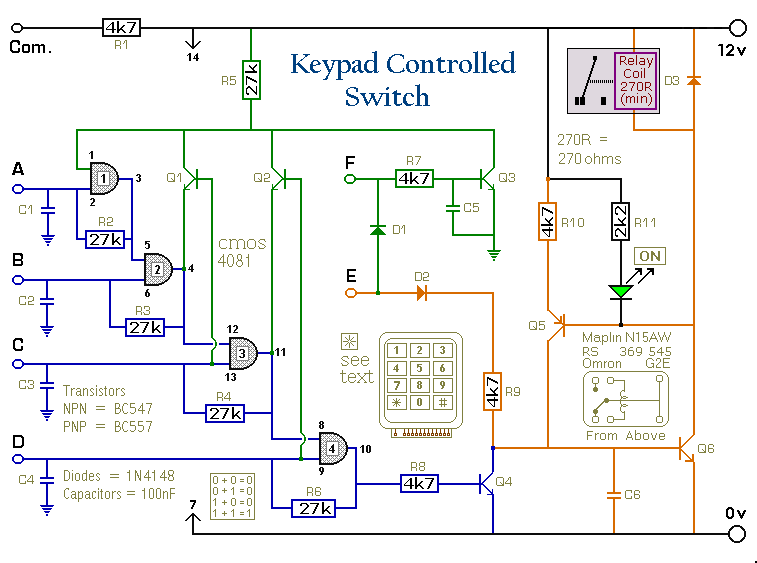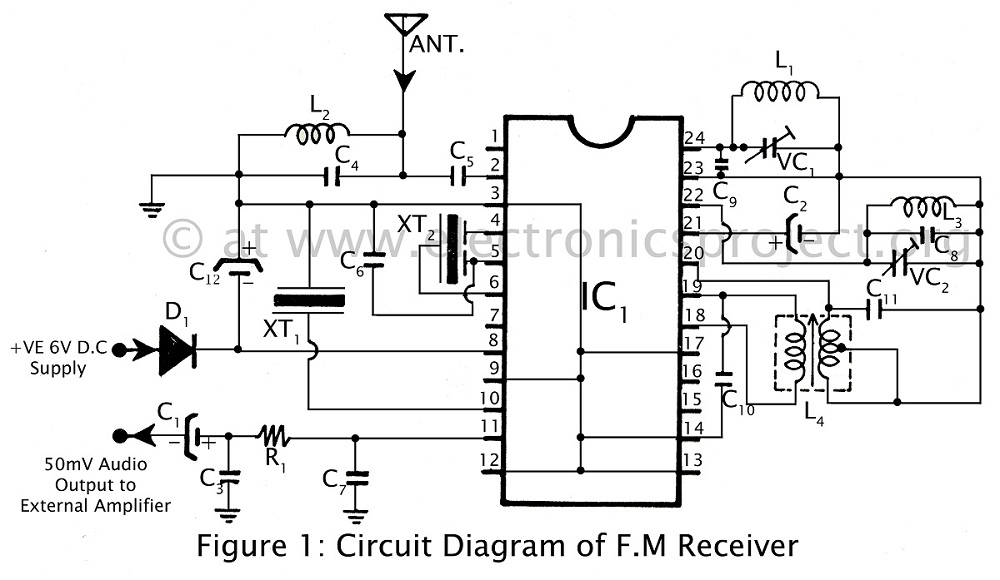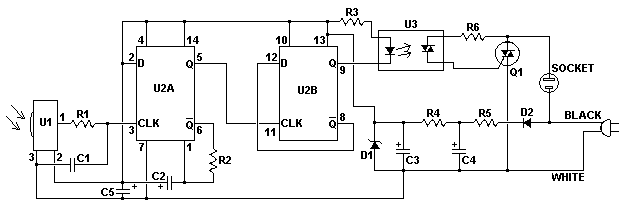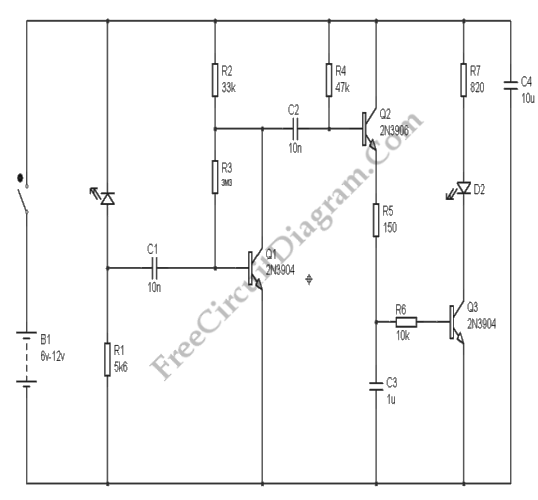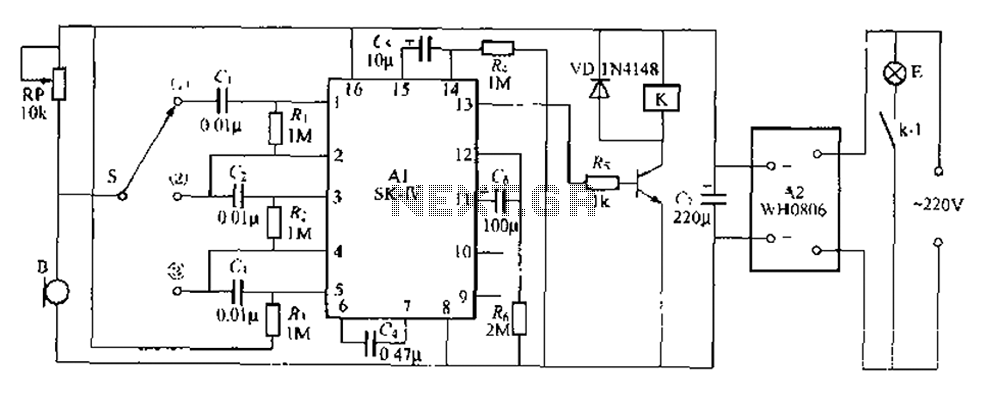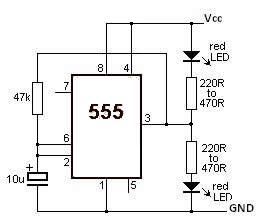
simple switch off time delay schematic

The two circuits illustrated show the operation of opening a relay contact shortly after the ignition or light switch is turned off. A capacitor is charged, and the relay remains closed until the voltage at the diode anode rises to 12 volts. The circuit on the left is a common collector (or emitter follower) configuration, which has the advantage of requiring one less component since no resistor is needed in series with the transistor base. However, the voltage across the relay coil will be two diode drops lower than the supply voltage, resulting in approximately 11 volts for a 12.5 volt input. The common emitter configuration on the right provides the benefit of applying the full supply voltage across the load for most of the delay period, minimizing concerns about the relay's pull-in and drop-out voltages, but necessitates an additional resistor in series with the transistor base. The common emitter circuit is preferable because the series base resistor can be adjusted to achieve the desired delay time, while the capacitor must be specifically selected for the common collector configuration or an additional resistor used in parallel with the capacitor. The time delay for the common emitter circuit will be approximately three time constants, calculated as 3 * R * C. The values for the capacitor and resistor can be determined based on the relay coil current and transistor gain. For instance, a relay coil with a resistance of 120 ohms will draw 100 mA at 12 volts. Assuming a transistor gain of 30, the base current will be 100 mA / 30 = 3 mA. The voltage across the resistor will be the supply voltage minus two diode drops, calculated as 12 volts - 1.4 volts = 10.6 volts. The resistor value can be computed using the formula voltage/current, resulting in 10.6 volts / 0.003 A = 3533 ohms, or approximately 3.6 kΩ. To achieve a 15-second delay, the capacitor value can be calculated as 15 seconds / (3 * R) = 1327 µF. A standard 1000 µF capacitor can be utilized, with a proportional increase in the resistor value to achieve the desired 15-second delay.
The two circuits presented serve to effectively manage the timing of relay activation in response to the ignition or light switch state. The common collector circuit, while simpler due to the absence of a series resistor, limits the voltage available to the relay coil, potentially affecting its performance during activation. In contrast, the common emitter circuit maximizes relay voltage, ensuring reliable operation, particularly in applications where the relay must operate within strict voltage parameters.
For practical implementation, the choice of components—specifically the capacitor and resistor—should be made with careful consideration of the relay specifications and the desired delay duration. The calculated values provide a solid foundation for selecting components, while adjustments may be necessary based on real-world testing. The use of a standard capacitor value, such as 1000 µF, simplifies sourcing components, and adjusting the resistor value allows for fine-tuning of the delay to meet specific requirements. Additionally, it is essential to ensure that the transistor selected can handle the required current and voltage levels, and that the diode used in the circuit is rated appropriately for the application to prevent damage and ensure reliable operation.The two circuits di atas illustrate opening a relay contact a short time after the ignition or ligh switch is turned off. The capacitor is charged and the relay is closed when the voltage at the diode anode rises to 12 volts.
The circuit on the left is a common collector or emitter follower and has the advantage of one less part since a resistor i s not needed in series with the transistor base. However the voltage across the relay coil will be two diode drops less than the supply voltage, or about 11 volts for a 12. 5 volt input. The common emitter configuration on the right offers the advantage of the full supply voltage across the load for most of the delay time, which makes the relay pull-in and drop-out voltages less of a concern but requires an extra resistor in series with transistor base.
The common emitter (circuit on the right) is the better circuit since the series base resistor can be selected to obtain the desired delay time whereas the capacitor must be selected for the common collector (or an additional resistor used in parallel with the capacitor). The time delay for the common emitter will be approximately 3 time constants or 3*R*C. The capacitor/resistor values can be worked out from the relay coil current and transistor gain. For example a 120 ohm relay coil will draw 100 mA at 12 volts and assumming a transistor gain of 30, the base current will be 100/30 = 3 mA.
The voltage across the resistor will be the supply voltage minus two diode drops or 12-1. 4 = 10. 6. The resistor value will be the voltage/current = 10. 6/0. 003 = 3533 or about 3. 6K. The capacitor value for a 15 second delay will be 15/3R = 1327 uF. We can use a standard 1000 uF capacitor and increase the resistor proportionally to get 15 seconds. 🔗 External reference
The two circuits presented serve to effectively manage the timing of relay activation in response to the ignition or light switch state. The common collector circuit, while simpler due to the absence of a series resistor, limits the voltage available to the relay coil, potentially affecting its performance during activation. In contrast, the common emitter circuit maximizes relay voltage, ensuring reliable operation, particularly in applications where the relay must operate within strict voltage parameters.
For practical implementation, the choice of components—specifically the capacitor and resistor—should be made with careful consideration of the relay specifications and the desired delay duration. The calculated values provide a solid foundation for selecting components, while adjustments may be necessary based on real-world testing. The use of a standard capacitor value, such as 1000 µF, simplifies sourcing components, and adjusting the resistor value allows for fine-tuning of the delay to meet specific requirements. Additionally, it is essential to ensure that the transistor selected can handle the required current and voltage levels, and that the diode used in the circuit is rated appropriately for the application to prevent damage and ensure reliable operation.The two circuits di atas illustrate opening a relay contact a short time after the ignition or ligh switch is turned off. The capacitor is charged and the relay is closed when the voltage at the diode anode rises to 12 volts.
The circuit on the left is a common collector or emitter follower and has the advantage of one less part since a resistor i s not needed in series with the transistor base. However the voltage across the relay coil will be two diode drops less than the supply voltage, or about 11 volts for a 12. 5 volt input. The common emitter configuration on the right offers the advantage of the full supply voltage across the load for most of the delay time, which makes the relay pull-in and drop-out voltages less of a concern but requires an extra resistor in series with transistor base.
The common emitter (circuit on the right) is the better circuit since the series base resistor can be selected to obtain the desired delay time whereas the capacitor must be selected for the common collector (or an additional resistor used in parallel with the capacitor). The time delay for the common emitter will be approximately 3 time constants or 3*R*C. The capacitor/resistor values can be worked out from the relay coil current and transistor gain. For example a 120 ohm relay coil will draw 100 mA at 12 volts and assumming a transistor gain of 30, the base current will be 100/30 = 3 mA.
The voltage across the resistor will be the supply voltage minus two diode drops or 12-1. 4 = 10. 6. The resistor value will be the voltage/current = 10. 6/0. 003 = 3533 or about 3. 6K. The capacitor value for a 15 second delay will be 15/3R = 1327 uF. We can use a standard 1000 uF capacitor and increase the resistor proportionally to get 15 seconds. 🔗 External reference
